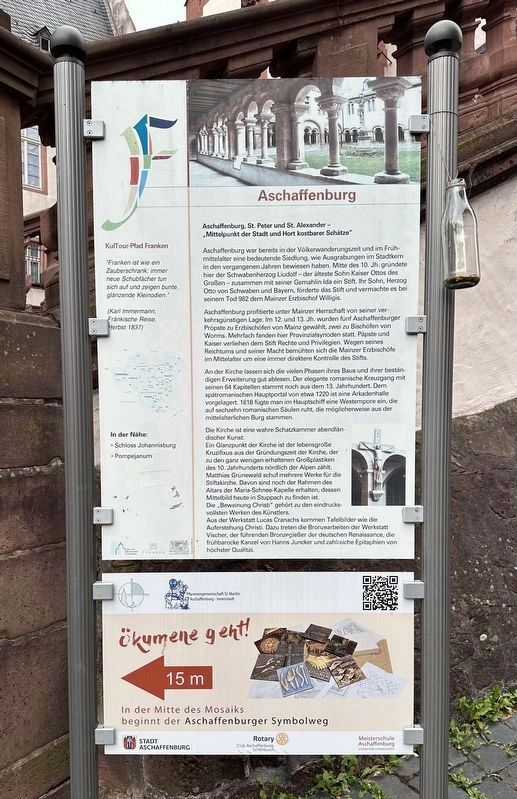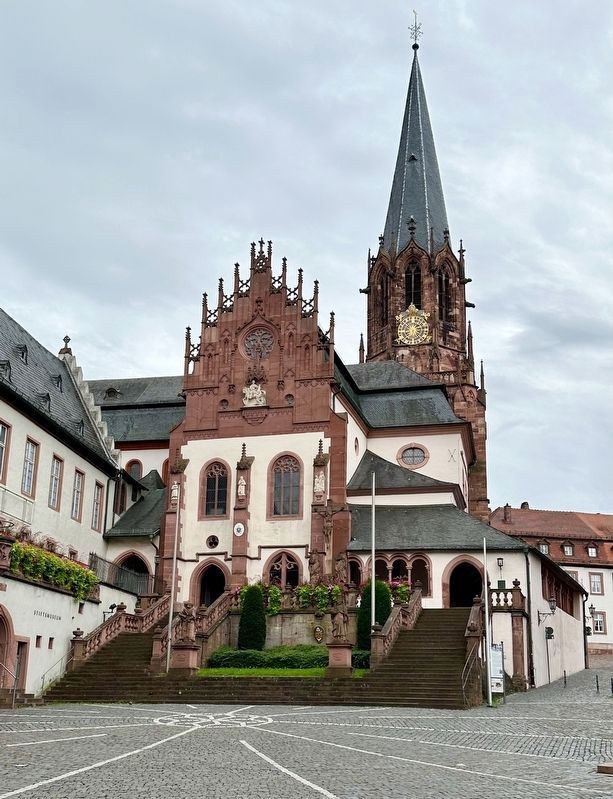Innenstadt in Aschaffenburg, Bavaria, Germany — Central Europe
Aschaffenburg

Photographed By Andrew Ruppenstein, September 18, 2023
1. Aschaffenburg Marker
Note the bottom panel here is not really part of the marker, but rather indicates the starting point of an “ecumenical trail”, which is a set of Christian-themed art plaques strung out separately as a path to wander and ponder.
„Mittelpunkt der Stadt und Hort kostbarer Schätze"
Aschaffenburg war bereits in der Völkerwanderungszeit und im Frühmittelalter eine bedeutende Siedlung, wie Ausgrabungen im Stadtkern in den vergangenen Jahren bewiesen haben. Mitte des 10. Jh. gründete hier der Schwabenherzog Liudolf- der älteste Sohn Kaiser Ottos des Großen - zusammen mit seiner Gemahlin Ida ein Stift. Ihr Sohn, Herzog Otto von Schwaben und Bayern, förderte das Stift und vermachte es bei seinem Tod 982 dem Mainzer Erzbischof Willigis.
Aschaffenburg profitierte unter Mainzer Herrschaft von seiner ver- kehrsgünstigen Lage. Im 12. und 13. Jh. wurden fünf Aschaffenburger Pröpste zu Erzbischöfen von Mainz gewählt, zwei zu Bischöfen von Worms. Mehrfach fanden hier Provinzialsynoden statt. Päpste und Kaiser verliehen dem Stift Rechte und Privilegien. Wegen seines Reichtums und seiner Macht bemühten sich die Mainzer Erzbischöfe im Mittelalter um eine immer direktere Kontrolle des Stifts.
An der Kirche lassen sich die vielen Phasen ihres Baus und ihrer beständigen Erweiterung gut ablesen. Der elegante romanische Kreuzgang mit seinen 64 Kapitellen stammt noch aus dem 13. Jahrhundert. Dem spätromanischen Hauptportal von etwa 1220 ist eine Arkadenhalle vorgelagert. 1618 fügte man im Hauptschiff eine Westempore ein, die auf sechzehn romanischen Säulen ruht, die möglic weise aus der mittelalterlichen Burg stammen.
Die Kirche ist eine wahre Schatzkammer abendländischer Kunst: Ein Glanzpunkt der Kirche ist der lebensgroße Kruzifixus aus der Gründungszeit der Kirche, der zu den ganz wenigen erhaltenen Großplastiken des 10. Jahrhunderts nördlich der Alpen zählt. Matthias Grünewald schuf mehrere Werke für die Stiftskirche. Davon sind noch der Rahmen des Altars der Maria-Schnee-Kapelle erhalten, dessen Mittelbild heute in Stuppach zu finden ist. “Die Beweinung Christi” gehört zu den eindrucksvollsten Werken des Künstlers. Aus der Werkstatt Lucas Cranachs kommen Tafelbilder wie die Auferstehung Christi. Dazu treten die Bronzearbeiten der Werkstatt Vischer, der führenden Bronzegießer der deutschen Renaissance, die frühbarocke Kanzel von Hanns Juncker und zahlreiche Epitaphien von höchster Qualität.
Aschaffenburg, St. Peter and St. Alexander -
"Center of the city and hoard of precious treasures"
Aschaffenburg was already an important settlement during
the migration period and the early Middle Ages, as excavations in the city center have proven in recent years. In the middle of the 10th century, the Swabian Duke Liudolf - the eldest son of Emperor Otto the Great - founded a monastery here together with his wife Ida. Her son, Duke Otto of Swabia and Bavaria, supported the monastery and bequeathed it to Archbishop Willigis of Mainz when he died in 982.
Under Mainz rule, Aschaffenburg benefited from its convenient location. In the 12th and 13th centuries, five Aschaffenburg provosts were elected archbishops of Mainz and two were elected bishops of Worms. Provincial synods have taken place here several times. Popes and emperors gave the monastery rights and privileges. Because of its wealth and power, the archbishops of Mainz sought increasingly direct control of the monastery in the Middle Ages.
The many phases of its construction and constant expansion can be clearly seen in the church. The elegant Romanesque cloister with its 64 capitals dates back to the 13th century. There is an arcade hall in front of the late Romanesque main portal from around 1220. In 1618, a west gallery was added to the main nave, which rests on sixteen Romanesque columns, which may have come from the medieval castle.
The church is a true treasure trove of Western art: A highlight of the church is the life-size crucifix
from the time the church was founded, which is one of the very few large-scale sculptures from the 10th century that have been preserved north of the Alps. Matthias Grünewald created several works for the collegiate church. The frame of the altar of the Maria Snow Chapel, whose central picture can now be found in Stuppach, is still preserved. The “Lamentation of Christ” is one of the artist's most impressive works. Panel paintings such as the Resurrection of Christ come from Lucas Cranach's workshop. There are also the bronze works from the Vischer workshop, the leading bronze casters of the German Renaissance, the early Baroque pulpit by Hanns Juncker and numerous epitaphs of the highest quality.
Erected by Haus der Bayerischen Geschichte.
Topics. This historical marker is listed in these topic lists: Arts, Letters, Music • Churches & Religion • Settlements & Settlers. A significant historical year for this entry is 1220.
Location. 49° 58.428′ N, 9° 8.758′ E. Marker is in Aschaffenburg, Bayern (Bavaria). It is in Innenstadt. Marker is on Stiftsgasse, on the left when traveling south. Touch for map. Marker is at or near this postal address: Stiftsgasse 3, Aschaffenburg BY 63739, Germany. Touch for directions.
Other nearby markers. At least 6 other markers are within walking distance of this marker. Stiftsbrunnen / Collegiate Church Fountain (a few steps from this marker); Dr. Johannes Kirsch (about 90 meters away, measured in a direct line); Ehemaliger Ballsaal / Former Ballroom (about 120 meters away); Schmerlenbacher Klosterhof / Schmerlenbach Convent (about 150 meters away); Peter Gingold (about 210 meters away); Prinzessin Alexandra Amalie / Princess Alexandra Amalie (approx. 0.3 kilometers away).
Also see . . .
1. St. Peter und Alexander (Aschaffenburg) (Wikipedia).
Overview: The Kollegiatsstift St. Peter und Alexander (also Stiftskirche Aschaffenburg or collegiate church Aschaffenburg or Basilica of SS. Peter and Alexander) is a Catholic church located in Aschaffenburg, Bavaria, Germany. It is the town's oldest church, established in the 10th century, dedicated to Saint Peter and Saint Alexander. The main building was built as a Roman basilica, while other phases were built in the early Gothic style. The current structure is a cruciform basilica, reflecting a variety of styles including a Romanesque nave from the 12th century and a 15th-century tower.(Submitted on December 25, 2023.)
The church is also notable for its Renaissance painting Beweinung Christi by Matthias Grünewald and the 10th-century Triumphkreuz. The Stiftskirche is open to the public and serves as a Roman Catholic parish church. A museum in the former chapter house exhibits church treasures and other historical artifacts.
2. Aschaffenburg (Wikipedia).
Early history: Aschaffenburg was originally a settlement of the Alamanni. Roman legions were stationed here…(Submitted on December 25, 2023.)
Around 550, the area had been conquered by the Franks, and their Hausmeier built a castle here. In the 8th century, a Benedictine monastery was founded, dedicated to St. Michael, reportedly by Saint Boniface. This became the Kollegiatstift St. Peter und Alexander in the second half of the 10th century (957). In 869, King Louis the Younger married Liutgard of Saxony at Aschaffenburg. She also died here in 885 and was later laid to rest with her daughter Hildegard in the Stiftskirche. Ascaffinburg is mentioned first in 974 in a gift document by Otto II, in which he gave several villages including Wertheim am Main and a stretch of forest in the Spessart to the collegiate church.
In the Middle Ages the town was known as Ascaffaburc, Ascapha or Ascaphaburg. A stone bridge over the Main was reportedly built by Archbishop Willigis in 989, who also made the town his second residence. The town (referred to in 975 as a civitas) was part of the Archbishopric of Mainz from 982, when Duke Otto died. A Vizedom is mentioned for the first time in 1122 as the top local representative of the Archbishop. In 1292 a synod was held here, and in 1447 an imperial diet, preliminary to that of Vienna, approved a concordat (sometimes called the Aschaffenburg Concordat). In the German Peasants' War (1525), the town backed the losing side.
Credits. This page was last revised on December 25, 2023. It was originally submitted on December 25, 2023, by Andrew Ruppenstein of Lamorinda, California. This page has been viewed 46 times since then and 7 times this year. Photos: 1, 2, 3. submitted on December 25, 2023, by Andrew Ruppenstein of Lamorinda, California.

